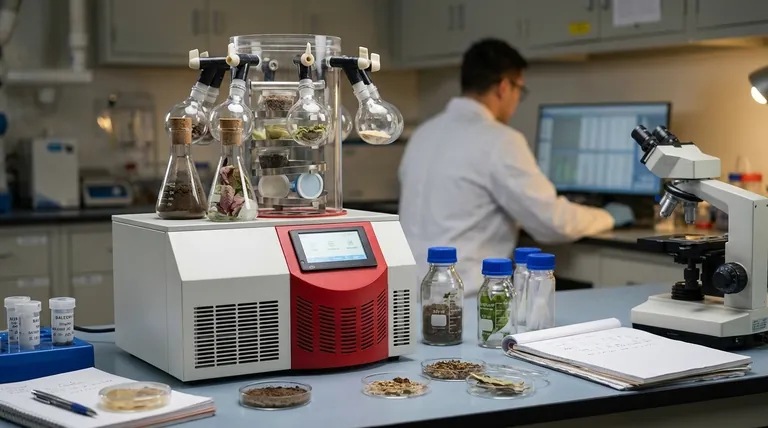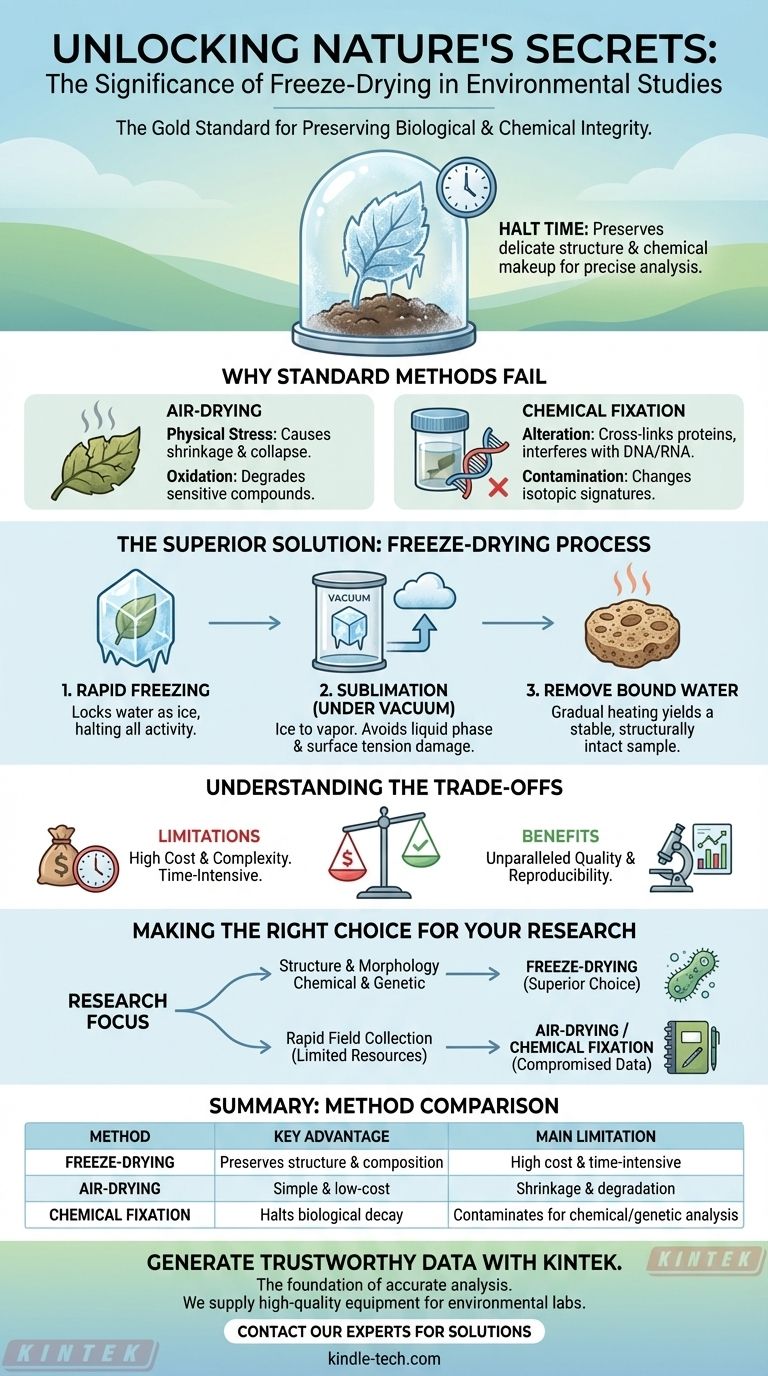At its core, freeze-drying is a critical tool in environmental studies because it offers the most effective method for preserving the biological and chemical integrity of samples. Unlike simple drying or chemical fixation, this process, also known as lyophilization, removes water without significantly damaging the sample's physical structure or altering its composition, ensuring that subsequent analyses are accurate and reliable.
The true significance of freeze-drying lies in its ability to halt time. By removing water through sublimation, it locks a sample in a state of suspended animation, preserving its delicate structure and chemical makeup for precise scientific investigation.

Why Standard Preservation Methods Often Fail
Before understanding the value of freeze-drying, it's essential to recognize the limitations of conventional preservation techniques used in environmental science.
The Problem with Air-Drying
Air-drying is simple and cheap, but it causes significant physical stress. As water evaporates, surface tension causes cells to shrink and collapse, permanently altering the sample's original structure and porosity.
This method also exposes the sample to oxygen for extended periods at moderate temperatures, which can lead to oxidation and the degradation of sensitive chemical compounds.
The Drawbacks of Chemical Fixation
Using chemicals like formalin or ethanol can halt biological decay, but they fundamentally change the sample. These fixatives can cross-link proteins, interfere with genetic material (DNA/RNA), and alter the isotopic signatures that are crucial for many environmental analyses.
Essentially, the act of preserving the sample with chemicals contaminates it for many of the tests scientists need to run.
How Freeze-Drying Achieves Superior Preservation
Freeze-drying is a multi-step process engineered to bypass the damaging effects of other methods. It works by gently removing water while the sample is in a frozen state.
Step 1: Rapid Freezing
First, the sample is rapidly frozen. This locks water molecules in place as ice crystals, instantly preserving the sample's physical structure and halting all biological and most chemical activity.
Step 2: Sublimation Under Vacuum
The frozen sample is then placed in a vacuum chamber. The pressure is lowered significantly, and a small amount of heat is added, causing the ice to turn directly into water vapor without first melting into a liquid.
This process, called sublimation, is the key. By avoiding the liquid phase, the powerful surface tension of water is eliminated, preventing the cellular collapse and shrinkage seen in air-drying.
Step 3: Removing Bound Water
Finally, the temperature is gradually increased to remove any remaining water molecules that were chemically bound to the sample material. The result is a lightweight, structurally intact, and chemically stable sample.
Understanding the Trade-offs
While freeze-drying is the gold standard for many applications, it is not without its limitations. Objectivity requires acknowledging these factors.
High Cost and Complexity
Freeze-drying equipment is expensive to purchase and maintain. The process also requires specialized knowledge to operate correctly, making it less accessible for field researchers with limited budgets or facilities.
Time-Intensive Process
Lyophilization is not fast. Depending on the size and water content of the sample, a single run can take anywhere from several hours to several days to complete. This is a significant consideration for high-throughput studies.
Making the Right Choice for Your Research
Choosing a preservation method depends entirely on the data you need to collect. The method you use on-site determines the quality of questions you can answer in the lab.
- If your primary focus is structural or morphological analysis: Freeze-drying is unparalleled for preserving the delicate, three-dimensional features of plants, soils, or biological tissues.
- If your primary focus is chemical, isotopic, or genetic analysis: Freeze-drying is the superior choice to prevent contamination and degradation of the very molecules you intend to study.
- If your primary focus is rapid field collection with limited resources: Air-drying or chemical fixation may be your only options, but you must acknowledge and account for the potential data compromises in your final analysis.
Ultimately, employing the right preservation technique is the foundational step toward generating trustworthy and reproducible environmental data.
Summary Table:
| Method | Key Advantage | Main Limitation |
|---|---|---|
| Freeze-Drying | Preserves physical structure & chemical composition | High cost and time-intensive |
| Air-Drying | Simple and low-cost | Causes sample shrinkage and degradation |
| Chemical Fixation | Halts biological decay | Contaminates sample for chemical/genetic analysis |
Generate Trustworthy Environmental Data with KINTEK
The right preservation technique is the foundation of accurate analysis. For researchers who cannot compromise on sample integrity, KINTEK provides the reliable lab equipment you need.
We specialize in supplying environmental science laboratories with high-quality equipment and consumables. Let us help you ensure your samples are preserved perfectly for structural, chemical, isotopic, and genetic analysis.
Contact our experts today to find the ideal preservation solution for your specific research needs.
Visual Guide

Related Products
- Benchtop Laboratory Freeze Dryer for Lab Use
- Laboratory Sterilizer Lab Autoclave Pulsating Vacuum Desktop Steam Sterilizer
- Laboratory High Pressure Steam Sterilizer Vertical Autoclave for Lab Department
- Desktop Fast Laboratory Autoclave Sterilizer 35L 50L 90L for Lab Use
- Portable High Pressure Laboratory Autoclave Steam Sterilizer for Lab Use
People Also Ask
- What role does freeze drying play in scientific research? Preserve Sample Integrity for Reliable Results
- What are the main steps involved in the freeze-drying process? A Guide to the 3 Key Stages
- Why is freeze drying considered more effective than ordinary drying? Preserve Structure, Nutrients & Flavor
- Why are laboratory freeze dryers considered economical tools? Maximize Value and Minimize Loss
- What is the purpose of laboratory freeze drying? Preserve Sensitive Drugs & Biologics for Stability


















